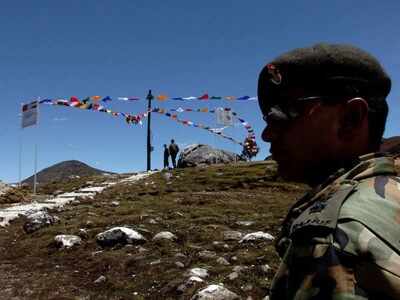Top Searches
- News
- India News
- India, China will resolve border stand-off peacefully, says MEA
India, China will resolve border stand-off peacefully, says MEA

NEW DELHI: A day after Indian and Chinese army commanders met at the Chushul-Moldo point on the Line of Actual Control (LAC) in Ladakh, the foreign ministry said both sides have agreed to peacefully resolve the month-long confrontation triggered by the intrusion of Chinese troops into areas patrolled by India.
"Both sides agreed to peacefully resolve the situation in the border areas in accordance with various bilateral agreements,” the ministry of external affairs said. There was no official statement on Saturday after an Indian delegation crossed into Chinese-held territory to hold extensive discussions seen to be purposeful in setting into motion the process of de-escalation along points in the Galwan Valley, Gogra and Pangong Tso. TOI had reported on June 7 that the talks had ended on a positive note.
Describing the talks as being held in a “cordial and positive atmosphere”, the MEA statement made it clear that India would hinge its assessment of the bilateral relationship on peace on the borders, “keeping in view the agreement between the leaders that peace and tranquillity in the India-China border regions is essential for the overall development of bilateral relations”.
The meeting between the military brass, which went on for over five hours, will be repeated in the coming days and weeks. “The two sides will continue the military and diplomatic engagements to resolve the situation and to ensure peace and tranquillity in the border areas,” the MEA said.
“Both sides also noted that this year marked the 70th anniversary of establishment of diplomatic relations between the two countries and agreed that an early resolution would contribute to further development of the relationship,” it added. India and China had planned 70 events to mark the seven decades of diplomatic ties, a decision taken at the Mamallapuram informal summit.
The India-China military meeting on Saturday was followed on Sunday by slickly made videos by the Chinese government showing army movements to the India-China border in Ladakh, as part of information warfare tactics, all intended to intimidate the Indian side. The Indian military build-up at the points of intrusion and in supporting positions, however, is significant and the political leadership is clear that the Chinese army will need to withdraw.
The military meeting followed a virtual conference on Friday between Naveen Srivastava, joint secretary, east Asia, in MEA and his counterpart Wu Jianghao, director general in the Chinese ministry of foreign affairs, on bilateral relations with a special focus on the current stand-off. “Both sides agreed that in accordance with the guidance provided by the leadership, the two sides should handle their differences through peaceful discussion bearing in mind the importance of respecting each other's sensitivities, concerns and aspirations and not allow them to become disputes,” the MEA had said after the meeting.
"Both sides agreed to peacefully resolve the situation in the border areas in accordance with various bilateral agreements,” the ministry of external affairs said. There was no official statement on Saturday after an Indian delegation crossed into Chinese-held territory to hold extensive discussions seen to be purposeful in setting into motion the process of de-escalation along points in the Galwan Valley, Gogra and Pangong Tso. TOI had reported on June 7 that the talks had ended on a positive note.
Describing the talks as being held in a “cordial and positive atmosphere”, the MEA statement made it clear that India would hinge its assessment of the bilateral relationship on peace on the borders, “keeping in view the agreement between the leaders that peace and tranquillity in the India-China border regions is essential for the overall development of bilateral relations”.
The meeting between the military brass, which went on for over five hours, will be repeated in the coming days and weeks. “The two sides will continue the military and diplomatic engagements to resolve the situation and to ensure peace and tranquillity in the border areas,” the MEA said.
“Both sides also noted that this year marked the 70th anniversary of establishment of diplomatic relations between the two countries and agreed that an early resolution would contribute to further development of the relationship,” it added. India and China had planned 70 events to mark the seven decades of diplomatic ties, a decision taken at the Mamallapuram informal summit.
The India-China military meeting on Saturday was followed on Sunday by slickly made videos by the Chinese government showing army movements to the India-China border in Ladakh, as part of information warfare tactics, all intended to intimidate the Indian side. The Indian military build-up at the points of intrusion and in supporting positions, however, is significant and the political leadership is clear that the Chinese army will need to withdraw.
The military meeting followed a virtual conference on Friday between Naveen Srivastava, joint secretary, east Asia, in MEA and his counterpart Wu Jianghao, director general in the Chinese ministry of foreign affairs, on bilateral relations with a special focus on the current stand-off. “Both sides agreed that in accordance with the guidance provided by the leadership, the two sides should handle their differences through peaceful discussion bearing in mind the importance of respecting each other's sensitivities, concerns and aspirations and not allow them to become disputes,” the MEA had said after the meeting.
FacebookTwitterLinkedinMail
Start a Conversation
end of article
Trending Topics
Quick Links
Coronavirus in MumbaiCoronavirus in KolkataCoronavirus in HyderabadCoronavirus in DelhiCoronavirus in BangaloreCoronavirus symptomsCoronavirus in IndiaWhat is CoronavirusCoronavirus NewsSolar EclipseNPRWhat is NRCCAB BillCAB and NRCRTI BillPodcast newsLok SabhaShiv SenaYSRCPCongressBJP newsUIDAIIndian ArmyISRO newsSupreme Court